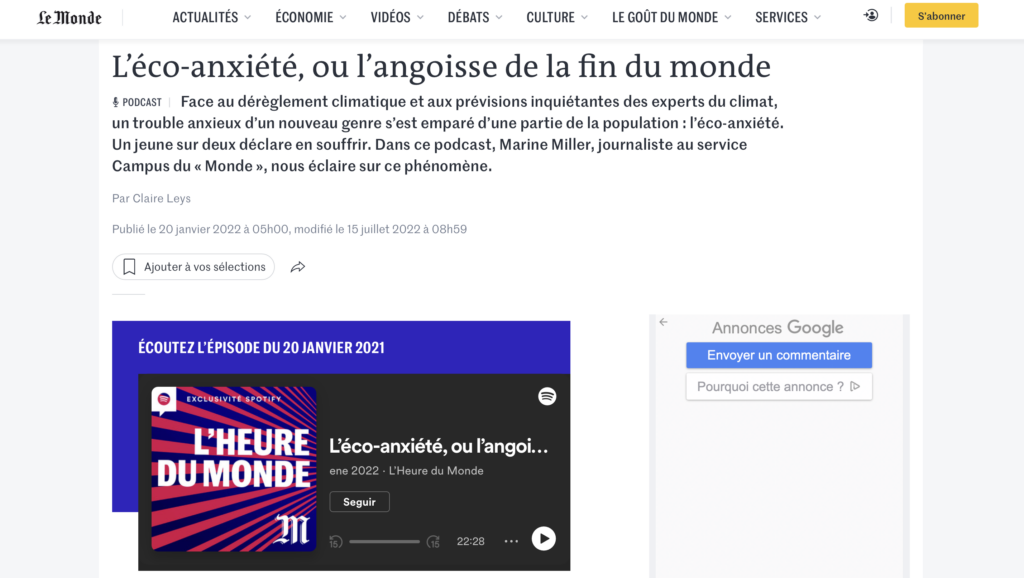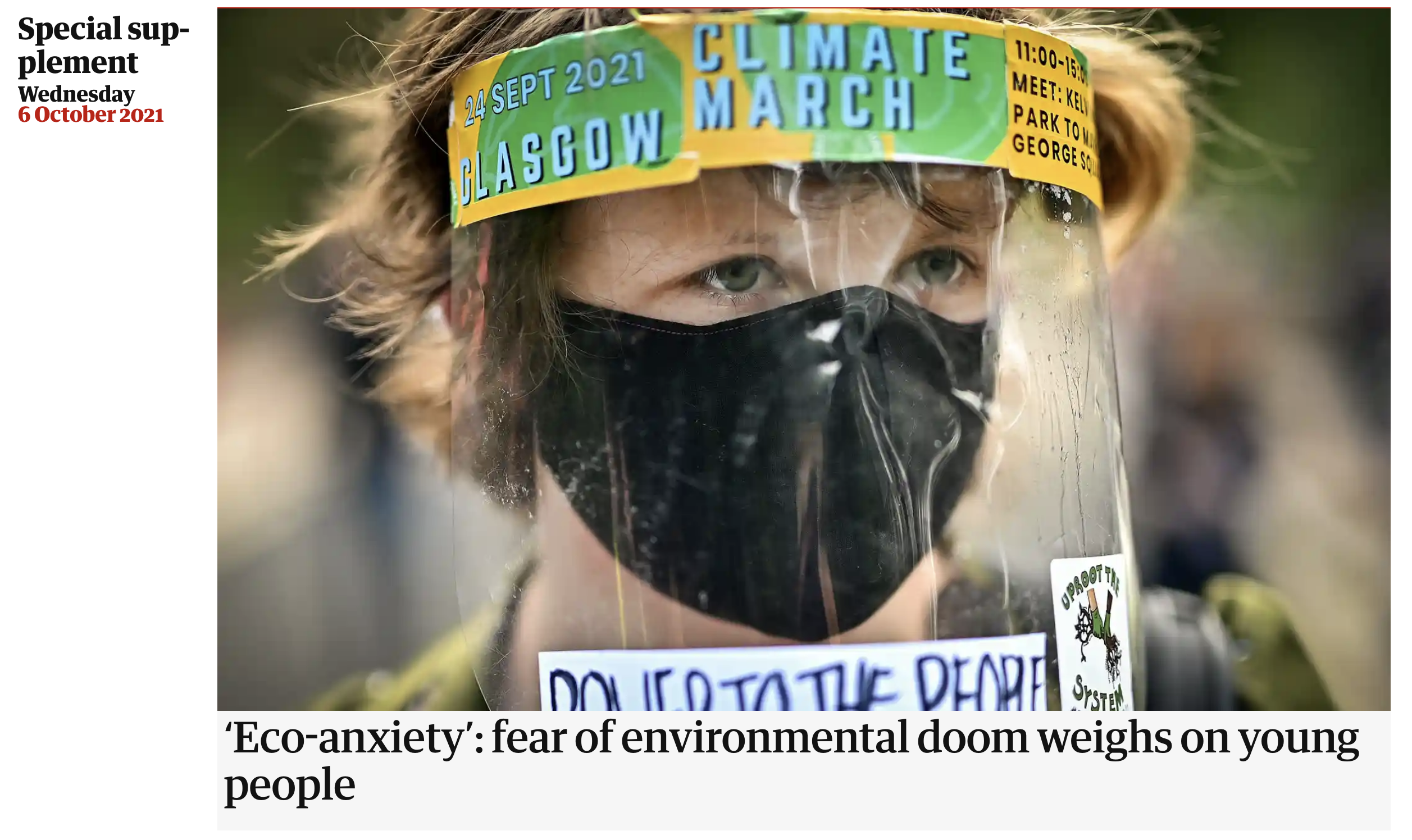Although the term ‘eco-anxiety’ already existed before, it has gained significant presence in European media over the past few years. We have examined La Vanguardia (Spain), The Guardian (UK) and Le Monde (France) to see how three prestigious newspapers from different countries address this phenomenon. In all cases, we present a quantitative and qualitative analysis.
What is eco-anxiety?
In December, 2021, the medical journal The Lancet published a study that showed that 45% of young people between 6 and 25 years suffered from climate anxiety and eco-anxiety. According to the American Psychological Association (APA), eco-anxiety is “the chronic fear of environmental cataclysm that comes from observing the seemingly irrevocable impact of climate change and the associated concern for one’s future and that of next generations”. As explained in The Lancet’s survey, this phenomenon is related to “a failure by governments to respond to the climate crisis”. Since it is a global issue, the European Commission and the European Environment Agency collaborated to create the European Climate and Health Observatory, devoted to reducing the impact of climate change on human health in Europe.
La Vanguardia
Searching for “ecoansiedad” in the search engine of La Vanguardia’s archive, we see 21 results for the print edition and 31 for the digital version. In the print edition, the first mention is in February 14, 2010, but then the term doesn’t appear again until January 25, 2020. We notice a significant emphasis during 2022 (9 and 16 times, in the print and the digital version, respectively), especially in the month of August. In 2023, the media presence decreases a little bit, but we still have 3 (print) and 7 (digital) results.
In most articles dedicated to eco-anxiety, La Vanguardia adopts an informational and often educational tone, paying attention to scientific data and sometimes including expert voices, such as the philosopher Jorge Riechmann, the historian Tiffany Watt, and the Director of the Public Health and Environment Department of the World Health Organization (WHO), María Neira. Occasionally, they publish features and articles which combine captivating paragraphs to keep the reader interested and strongly documented ones, with figures and scientific arguments (example 1, example 2). In the article “Qué es la ecoansiedad y cuáles son sus síntomas”, they present in a visual way the main symptoms of eco-anxiety and how to prevent it.

The print edition of August 21, 2022 is especially remarkable. On the front page, they expose that “the lack of education on climatic and energetic limits extend eco-anxiety”. La Vanguardia also dedicates a three-page feature in the society section to the topic and one opinion article next to the editorial (“Eco-anxiety and responsibility”). If between 2020 and 2022 most articles were educational and presented “eco-anxiety” as a relatively new concept, in 2023 it is introduced more naturally, taking for granted that readers know its meaning.
At the same time, La Vanguardia has also published some articles which include negative and mocking views of people who suffer eco-anxiety. In the editorial of November 6, 2022, the director of the newspaper wrote the following: “They are like those environmentalist radical groups, apostles of collapsism, who assume that the planet cannot be saved and, because of that, the only alternative is to act with hard methods against governments and companies. Behind these reactions there is the new phenomenon of eco-anxiety…”. In an article about a young activist, another journalist wrote: “The environmentalist faces the crisis without the apocalyptic discourse of the eco-anxiety”.
The Guardian
As the European Journalism Observatory exposes, The Guardian was a pioneer in covering climate change as an urgent issue. In 2019, the newspaper updated its style guide, recommending to use “climate emergency, crisis or breakdown” instead of “climate change”. When we do an advanced search in Google (“eco-anxiety” site: www.theguardian.com), we see 14 pages that, in total, show 136 different articles. The term “eco-anxiety” already appeared in 2007 and had a sporadic presence until 2017, but it was in late 2019, and especially between 2020 and 2022, when the newspaper dedicated more articles to this pathology.
Like La Vanguardia, The Guardian has also published some explanatory articles. In October 6, 2021, they dedicated a special supplement to the topic, with a central feature entitled “‘Eco-anxiety’: fear of environmental doom weighs on young people”. The newspaper’s approach to eco-anxiety is mostly scientific and rigorous, with links to official surveys and expert claims, as it can be seen in the articles “Half of child psychiatrists surveyed say patients have environment anxiety” and “Climate ‘apocalypse’ fears stopping people having children – study”. They also include real stories that humanize the phenomenon, as demonstrated in the pieces “‘Overwhelming and terrifying’: the rise of climate anxiety” and “Climate anxiety and PTSD are on the rise. Therapists don’t always know how to cope”. When necessary, they take part in the discussion: “Eco-anxiety isn’t pathological: it’s a legitimate reaction to the climate crisis”. Instead of emphasizing the alarmist dimension of eco-anxiety, they mostly present it as a logical feeling. In 2023, the term is more normalized, but they still address it professionally, considering the deontological codes of journalism.

Le Monde
When we do an advanced search in Google (“éco-anxiété” site: www.lemonde.fr), we see more than 20 pages with hundreds of results. Not all of them are strictly related to eco-anxiety, but we can certainly state that Le Monde has a regular coverage of climate change. The term “eco-anxiety” already appeared in 2019, but, like in La Vanguardia and The Guardian, the most prolific year was 2022.
Le Monde has also published explanatory features, like this podcast presented by Marine Miller, primarily based on The Lancet’s aforesaid study. Some headlines reflect that the newspaper is committed to raise awareness of climate emergency: “Les personnes éco-anxieuses sont lucides dans un monde qui ne l’est pas” (an interview with the doctor Alice Desbiolles), “Rentrée scolaire: ‘L’anxiété et l’écoanxiété chez les jeunes sont des problèmes à prendre très au sérieux’” (an interview with a collective of young activists).

The newspaper normally supports its arguments with human stories, especially interviews with teenagers, as it can be observed in pieces such as “L’écoanxiété, une crise existentielle pour certains adolescents” and “De jeunes ingénieurs et leur « éco-anxiété »”. In some articles, journalists emphasize dramatic words, such as “une crise existentielle”, “angoisses profondes de mort et de fin du monde”, “un été dominé par l’éco-anxiété”. However, the general tone of Le Monde is constructive and understanding.
Conclusion
In conclusion, in the last few years the term “eco-anxiety” has gained presence in La Vanguardia, The Guardian and Le Monde, especially after The Lancet showed in 2019 the real affectation among young people. In all cases, in 2022 there was an increase in the number of publications related to eco-anxiety. All newspapers managed to present the concept in an educational and empathetic tone. However, in La Vanguardia we notice some negative connotations and in Le Monde some dramatic words, whereas in The Guardian they maintain a proper perspective in almost all articles.
RESEARCH | ARTICLE © Berta Coll i Bosch. Universitat Pompeu Fabra.







